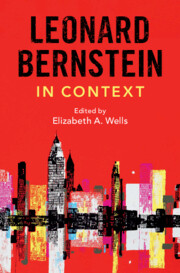Book contents
- Leonard Bernstein in Context
- Composers in Context
- Leonard Bernstein in Context
- Copyright page
- Contents
- Illustrations
- Musical Examples
- Contributors
- Preface
- Part I Bernstein’s World
- Part II Conducting
- Part III Composition, Creation, and Reception
- Part IV Bernstein as Musical and Cultural Ambassador
- Part V Connections
- Chapter 27 Aaron Copland
- Chapter 28 Stephen Schwartz
- Chapter 29 Stephen Sondheim
- Chapter 30 Kurt Weill
- Chapter 31 Jerome Robbins
- Chapter 32 William Schuman
- Chapter 33 Marc Blitzstein
- Part VI The Legacy
- Further Reading
- Index
Chapter 30 - Kurt Weill
from Part V - Connections
Published online by Cambridge University Press: 06 April 2024
- Leonard Bernstein in Context
- Composers in Context
- Leonard Bernstein in Context
- Copyright page
- Contents
- Illustrations
- Musical Examples
- Contributors
- Preface
- Part I Bernstein’s World
- Part II Conducting
- Part III Composition, Creation, and Reception
- Part IV Bernstein as Musical and Cultural Ambassador
- Part V Connections
- Chapter 27 Aaron Copland
- Chapter 28 Stephen Schwartz
- Chapter 29 Stephen Sondheim
- Chapter 30 Kurt Weill
- Chapter 31 Jerome Robbins
- Chapter 32 William Schuman
- Chapter 33 Marc Blitzstein
- Part VI The Legacy
- Further Reading
- Index
Summary
Bernstein mentioned Kurt Weill on only a few occasions, and yet his career as a composer for the stage followed a similar path. In particular, he created works that transcend the boundaries between opera and commercial theatre, tackling socio-political topics while writing melodies that reached the mainstream. This chapter traces the influence of Weill on Bernstein, who encountered Die Dreigroschenoper as a college student and would go on to conduct the premiere of Marc Blitzstein’s English adaptation, The Threepenny Opera, in 1952. The specific aesthetic traits which Bernstein absorbed from Weill’s scores are illustrated through comparative analyses of numbers from Trouble in Tahiti, Candide and West Side Story with, respectively, Lady in the Dark, Die Dreigroschenoper and Street Scene. Motivic, harmonic and structural elements of intertextuality reveal that Weill’s formal experimentation tilled the soil for works of music theatre that could be both indigenous and worldly, sophisticated and accessible.
Keywords
- Type
- Chapter
- Information
- Leonard Bernstein in Context , pp. 251 - 262Publisher: Cambridge University PressPrint publication year: 2024

